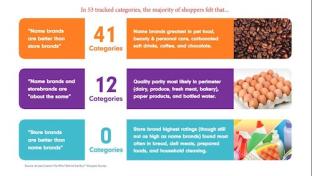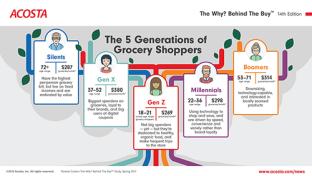Shelf Management Can Boost Retail Sales: Acosta Research
When it comes to growing sales, retailers and their suppliers should make sure they pay attention to what’s going on at shelf level, according to a new report from sales and marketing agency Acosta, “Shelf Management: The Value of Space Done Right.”
“Shoppers report that more than half of their grocery buying decisions are made at the shelf, proving that influence in store is crucial for brand success,” said John Clevenger, SVP/managing director, strategic advisors at Jacksonville, Fla.-based Acosta. “It has become imperative to shift to a comprehensive approach for shelf management. Traditional practices like slotting fees still matter, but new technological advances provide game-changing insights and incorporating them can create a competitive advantage for leading-edge manufacturers and retailers.”
Among the findings of the report:
The Importance of Getting the Shelf Right
- Manufacturers spend $100 billion annually on promotions, versus $300 million on shelf management, yet shelf management accounts for 66 percent of sales and 85 percent of profits.
- While the industry has seen a decline in lift from promotional tactics over the past several years, "fixing the shelf" yields a 6 percent sales lift.
- Fifty-five percent of shoppers decide which brand to buy in store, with common in-store purchasing decisions regarding spices/seasonings, cookies, meat marinades/rubs, chocolate candy and tuna.
Key Trends Affecting the Shelf
- Private brands tend to get more shelf space than they deserve and are 11 percent over-spaced on average, which can have an adverse effect on productivity and out-of-stocks.
- As the perimeter of the store continues to rise in popularity, many retailers have responded by shrinking center store to allocate more space to such sections as delis, prepared foods, organic foods and fresh produce.
- Retailers have responded to the rise of ecommerce in various ways, among them providing grocery pickup services and offering less assortment in store and larger assortment online.
Shelf Management Tech Upgrades, Analytics
- Virtual shopping research tracks shopper responses to a digitally created shopping experience to determine the optimal balance between speed, cost and accuracy.
- Simulated eye tracking predicts what shoppers will see in the first three to five seconds of shopping, and can influence what the shopper ultimately purchases from the shelf.
- Trax technology captures everything a shopper would see in-store, and then digitizes shelf images down to the SKU level to minimize out-of-stocks – estimated at $54 billion in lost sales – ensure effective in-store execution/pricing and see what competitors are doing at the shelf.
“Advancements in technology and automation have transformed shelf management from an art to a new level of science,” Noted Acosta SVP, Space Management Solutions Jim Hanson. “At times, manufacturers and retailers have chosen to invest in other category management practices besides the shelf, since it can be difficult to quantify the impact of shelving activities. Retailers can now create a more efficient shelf management process, and therefore spend more time on high value analytics which is what truly drives sales.”
“Shelf Management: The Value of Space Done Right” was compiled from a range of Acosta's resources, including an online survey of its proprietary shopper community.






